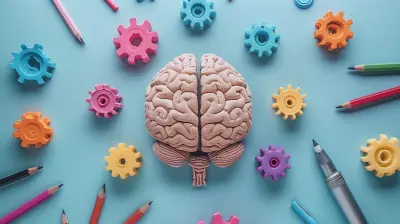Understanding Trauma and Its Impact on Mental Health
5 November 2025
Let’s face it—life throws curveballs. Whether it's a car accident, childhood neglect, or losing someone close, trauma doesn't knock before it enters. And once it's in, it tends to overstay its welcome.
But what exactly is trauma? How does it sneak into our minds and affect how we live, think, and feel? And most importantly—how can we deal with it?
In this deep dive, we're going to unpack what trauma really is, how it messes with your mental health, and what steps you can take to heal. So grab a cozy drink, take a breath, and let's talk about it—heart to heart.
What Is Trauma, Really?
Trauma isn't just what happens to you—it's what happens inside you as a result of what happened.You could say it’s like dropping a glass on the floor. The fall is the event, the shatter is the trauma. And each broken piece represents how it affects your thoughts, emotions, relationships, and even your body.
Types of Trauma
Trauma comes in all shapes and sizes. It’s not just the “big T” events like natural disasters or violent accidents. It can be subtle and still shake your world.Here are the most common types:
- Acute Trauma: A single incident (car crash, sudden death, assault)
- Chronic Trauma: Repeated and prolonged exposure (abuse, bullying, domestic violence)
- Complex Trauma: Exposure to varied and multiple traumatic events, often during early development
- Developmental Trauma: Trauma that occurs in childhood or adolescence, affecting psychological growth
- Vicarious Trauma: Indirect trauma experienced by witnessing or hearing about the trauma of others (common in healthcare professionals, social workers, etc.)
So yes, even that thing you’ve been telling yourself to “just get over”—it might be trauma.
How Trauma Shows Up in Everyday Life
Here’s the mind-boggling part: trauma doesn’t just live in your memories. It leaks into your daily behaviors, choices, and interactions without you even realizing it.Emotional Fallout
Ever felt like you're too emotional or too numb? That’s trauma messing with your emotional volume knob.- Mood swings
- Deep sadness or depression
- Anxiety or chronic worry
- Guilt or shame
- Emotional numbness or detachment
All of these can stem from unprocessed trauma.
Mental Health Struggles
Trauma can distort the way you think. It’s like installing a filter on your brain that only lets in fear and doubt.It’s tightly linked to conditions like:
- PTSD (Post-Traumatic Stress Disorder)
- Depression
- Anxiety Disorders
- Borderline Personality Disorder
- Substance Abuse Disorders
And the thing is—you might not always trace these back to trauma. You just feel like something’s wrong, but you can’t put your finger on what.
Physical Reactions
Yep, trauma even has the nerve to mess with your body. Ever heard the phrase “the body keeps the score”? It couldn’t be more true.You might notice:
- Chronic fatigue
- Headaches
- Digestive issues
- Muscle tension
- Rapid heartbeat or shallow breathing
These are your body’s red flags. It’s trying to say: “Hey, something’s not okay in here.”
Why Trauma Affects Mental Health So Deeply
Imagine your brain as a beautifully wired smart home. Trauma? It short-circuits the electricity.The Brain on Trauma
Three key parts of your brain take the biggest hit:1. Amygdala (the smoke detector): Goes into overdrive, spotting danger everywhere—even where there isn't any.
2. Hippocampus (the memory keeper): Struggles to file traumatic memories properly, causing flashbacks or dissociation.
3. Prefrontal Cortex (the decision-maker): Gets pushed aside, making it harder to think clearly or make rational decisions when triggered.
This brain imbalance keeps you stuck in survival mode, like your body is constantly shouting “Threat!” even when you’re safe.
Fight, Flight, Freeze, Fawn
These are your built-in response modes to trauma. They helped your ancestors survive, but repeated activation messes with your mental health.- Fight: Anger outbursts, control issues
- Flight: Perfectionism, anxiety, overworking
- Freeze: Depression, dissociation, feeling stuck
- Fawn: People-pleasing, lack of boundaries
Do any of these sound familiar? You’re not alone.
Unpacking Childhood Trauma
Let’s zoom in on one of the sneakiest and most powerful kinds—childhood trauma.When the people who are supposed to protect you are the source of pain, it rewires your entire understanding of safety, love, and trust.
Adverse Childhood Experiences (ACEs)
ACEs are traumatic events that happen before the age of 18. These include abuse, neglect, household dysfunction, etc. Studies show that the more ACEs you have, the higher your risk of developing mental and physical health problems later in life.But here’s the thing—your past doesn’t have to define your future. Healing is always possible.
How to Know If You’re Still Carrying Trauma
Sometimes it’s not obvious. Trauma is sneaky. It camouflages itself, hiding behind habits, fears, and reactions.Here are some signs that trauma might still be holding the reins:
- You overreact (or underreact) to small things
- You avoid certain people, places, or situations without knowing why
- You feel disconnected from yourself or others
- You struggle with low self-worth or impostor syndrome
- You feel stuck in a loop you can't break
If you're nodding your head right now, take a breath. Awareness is the first step toward healing.
The Road to Recovery: What Healing Looks Like
Now, the best part—yes, trauma may leave scars, but it doesn’t have to control your life. Healing is possible, and it's not as scary as it sounds.Therapy Is a Lifeline
Let’s break it down. You don’t have to lie on a couch and talk about your childhood (unless you want to). There are different types of therapy that work wonders with trauma:- Trauma-Informed Therapy: A compassionate and safe space that respects your boundaries
- CBT (Cognitive Behavioral Therapy): Helps you recognize and reframe harmful thought patterns
- EMDR (Eye Movement Desensitization and Reprocessing): Uses eye movements to reprocess traumatic memories
- Somatic Therapy: Focuses on bodily sensations to release stored tension
- IFS (Internal Family Systems): Helps you understand the “parts” of yourself affected by trauma
Therapy doesn’t “fix” you—it helps you fix your relationship with yourself.
Self-Care Isn’t Just Bubble Baths
Sure, a bubble bath helps. But real self-care is deeper.- Sleep: Your brain heals while you rest. Prioritize it.
- Movement: Trauma gets stuck in the body. Exercise and stretching help release it.
- Nutrition: A nourished body supports a balanced mind.
- Meditation and Mindfulness: Keeps you grounded in the now, not stuck in the past.
- Journaling: A safe space to release emotions and track your healing journey.
Start small. Even five minutes of mindfulness or movement a day can make a difference.
Say It with Me: Healing Is Not Linear
Some days you’ll feel like a warrior. Other days, a puddle. Both are okay.Progress might look like:
- Crying for the first time in years
- Saying “no” without guilt
- Setting a boundary and sticking to it
- Feeling joy without fear
Healing isn’t about erasing the past. It’s about integrating it into your story without letting it dictate your future.
Final Thoughts
If trauma had a voice, it would whisper, “You’re not safe.” But healing changes the narrative to, “You are safe now. You’re strong. And you’re not alone.”Understanding trauma and its impact on mental health isn’t just about psychology—it’s about reclaiming your life.
So if you’re carrying broken pieces, know this: you’re not broken. You’re rebuilding. And that, my friend, is a brave and beautiful thing.
all images in this post were generated using AI tools
Category:
Mental Health EducationAuthor:

Jenna Richardson
Discussion
rate this article
1 comments
Zephyrion McNeal
Trauma shapes us; understanding it heals us.
November 6, 2025 at 5:23 PM

Jenna Richardson
Absolutely, understanding trauma is a crucial step toward healing. It empowers us to navigate our experiences and fosters resilience. Thank you for your thoughtful comment!


